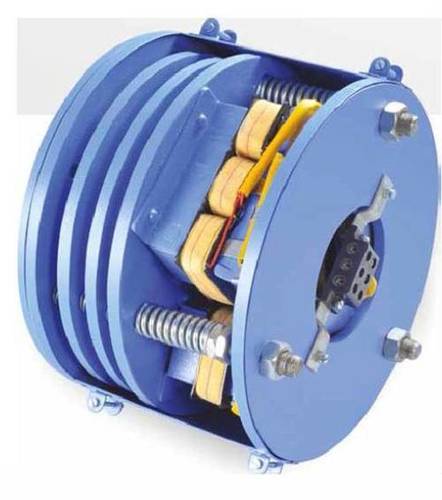
Electromagnetic Disc Brake
2500 आईएनआर
उत्पाद विवरण:
- ब्रेक Disc Brake
- रंग Blue
- शर्त
- उपयोग Industrial
- साइज 130mm
- ऑपरेटिंग मोड Automatic
- बिजली की आपूर्ति Electric
- Click to view more
X
इलेक्ट्रोमैग्नेटिक डिस्क ब्रेक मूल्य और मात्रा
- 1
- टुकड़ा/टुकड़े
इलेक्ट्रोमैग्नेटिक डिस्क ब्रेक उत्पाद की विशेषताएं
- Disc Brake
- Automatic
- Electric
- 130mm
- Industrial
- Blue
इलेक्ट्रोमैग्नेटिक डिस्क ब्रेक व्यापार सूचना
- म्यू एन डी आरए
- कैश ऑन डिलीवरी (COD), चेक
- 10 प्रति सप्ताह
- 5-8 दिन
- Yes
- नमूना लागत, शिपिंग और करों का भुगतान खरीदार द्वारा किया जाना है
- कार्टून बॉक्स पैकिंग
- उत्तरी अमेरिका, अफ्रीका, मिडल ईस्ट
- ऑल इंडिया
- एक आईएसओ 9001: 2008 प्रमाणित कंपनी
उत्पाद विवरण
An electromagnetic disc brake is a type of braking system that uses electromagnetic force to apply brakes and stop the rotation of a disc. This type of brake is commonly used in various applications, including industrial machinery, vehicles, and other systems where precise and controlled braking is required. Heres a brief overview of how electromagnetic disc brakes work: Basic Components: Electromagnet: The key component of the electromagnetic disc brake is the electromagnet. When an electric current passes through the electromagnet, it generates a magnetic field. Armature Plate: Attached to the rotating part (usually a disc or rotor) of the system is an armature plate made of ferrous material. This plate is attracted to the electromagnet when the magnetic field is activated. Operation: When the brake is in the released or off state, there is no current flowing through the electromagnet, and the armature plate is not attracted to it. When the braking action is required, an electric current is applied to the electromagnet, creating a magnetic field. The magnetic force attracts the armature plate towards the electromagnet. This movement causes the brake disc to be clamped between the armature plate and a stationary surface, creating friction and slowing down or stopping the rotation of the disc. Advantages: Precise Control: Electromagnetic disc brakes offer precise control over the braking force, allowing for gradual and controlled deceleration. Maintenance-Free: Since there are no physical contact parts during normal operation, electromagnetic brakes can be relatively maintenance-free compared to friction-based brakes. Applications: Industrial Machinery: Electromagnetic disc brakes are commonly used in various industrial applications, such as conveyor systems, cranes, and machine tools. Automotive: Some automotive applications, especially in electric or hybrid vehicles, may use electromagnetic disc brakes for regenerative braking. Product Specification Product Name Magnetic Disc Brake Product Code 02 Place of Origin Rajkot, Gujarat, India Advantages Low Maintenance, Easy Installation Application Order Details Packaging Details As Per Requirement Delivery Time 10 to 15 Days Port Mundra, Gujarat, India Minimum Order Quantity 1 PSC Supply Ability Any Payment tearms 100% advanceFAQs of Electromagnetic Disc Brake:
Q: What is the operating mode of the Electromagnetic Disc Brake?
A: The Electromagnetic Disc Brake operates in an automatic mode.Q: What is the size of the Electromagnetic Disc Brake?
A: The size of the Electromagnetic Disc Brake is 130mm.Q: What material is used to manufacture the Electromagnetic Disc Brake?
A: The Electromagnetic Disc Brake is made of MS (Mild Steel).Q: What is the warranty provided for the Electromagnetic Disc Brake?
A: The Electromagnetic Disc Brake comes with a 1-year warranty.Q: What standard does the Electromagnetic Disc Brake comply with?
A: The Electromagnetic Disc Brake complies with ISO 2008 standard.Tell us about your requirement

Price: Â
Quantity
Select Unit
- 50
- 100
- 200
- 250
- 500
- 1000+
Additional detail
मोबाइल number
Email
 08045801632
08045801632
 English
English Spanish
Spanish French
French German
German Italian
Italian Chinese (Simplified)
Chinese (Simplified) Japanese
Japanese Korean
Korean Arabic
Arabic Portuguese
Portuguese


 जांच भेजें
जांच भेजें एसएमएस भेजें
एसएमएस भेजें
